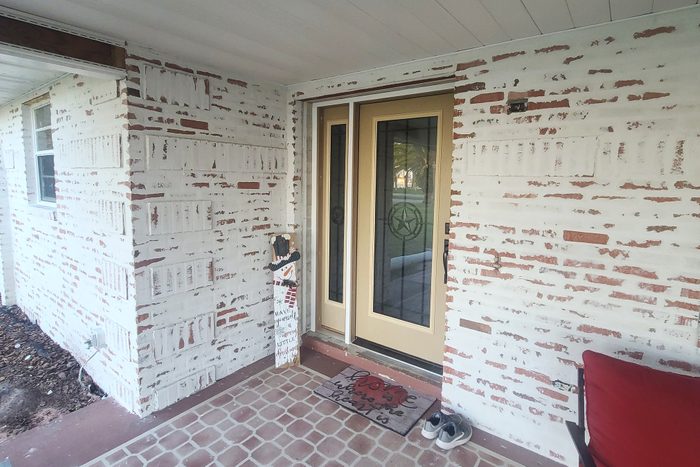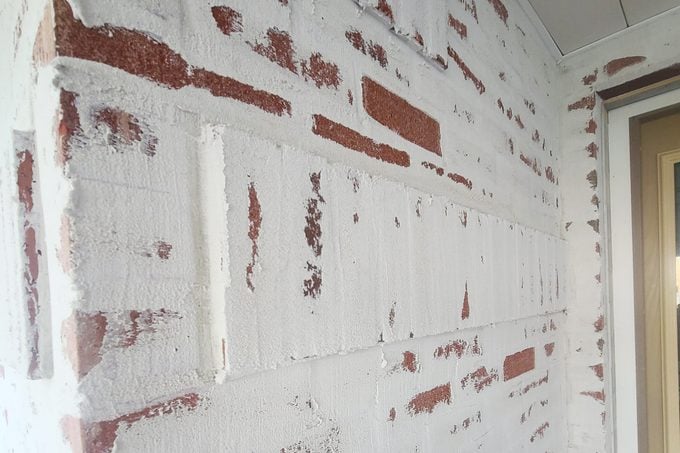What Is German Smear?
Updated: Jan. 30, 2024

If you're ready to revamp your plain brick house or fireplace but don't want to spend a lot of money, roll up your sleeves and consider German smear.
Brick offers permanence and security unmatched by other building materials. It’s no wonder we choose brick so frequently to construct our homes.
If you’ve smartly invested in a beautiful brick facade, get used to looking at it for a long time. Brick exteriors, unlike siding material like wood, can easily last 100 years or more, according to the International Association of Certified Home Inspectors.
However, you can change the look of your brick without knocking it down and starting over. Most of us are familiar with painted brick and whitewash, but what about German smear?
On This Page
What Is German Smear?
German smear is a mortar wash technique that transforms the look of plain brick. German smear brick facades look distressed or antiqued compared to uniform, single-color brick walls.
The “smear” comes from the Old High German word “schmieren,” which literally means “to smear.” (You’ve probably heard this word describing the act of putting cream cheese on a bagel.) German smear requires spreading mortar over existing brick, hence the name.
To accomplish the look, mortar — a mixture of sand, Portland cement and water — is spread across the face of a brick facade with a trowel, then partially wiped off with a wet sponge. The dried mortar gives the wall a lighter hue and rougher appearance, reminiscent of a country cottage.
Where To Use German Smear
German smear works well on your home’s exterior and interior brick surfaces. German smear fireplaces, exterior walls and floors are most common, but you could apply this technique wherever you have brick, like a kitchen backsplash or a masonry mailbox.
The brick doesn’t have to be new, but it should be unpainted. Smooth brick works best; mortar won’t stick to painted brick.
German Smear Pros and Cons

German smear fireplaces and brick exteriors offer a way to update your home without investing a fortune. If you’re intrigued by the rustic charm of German smear but aren’t sure if it’s right for you, here are some pros and cons to consider:
Pros
- It’s inexpensive. Ready-to-mix mortar and a few tools are all you need.
- It’s easy to apply. German smear doesn’t take a lot of know-how.
- It’s flexible. You can decide how thick or thin to apply the mortar, and how much brick to expose.
Cons
- It’s permanent. Be sure you want to radically change your brick’s appearance.
- It’s labor-intensive. While not difficult, German smear must be applied and finished by hand.
Is German Smear DIYable?
Yes. And it’s extremely forgiving. Because you’re going for old world charm, it doesn’t have to be exact. So even if you’re not an experienced DIYer, it’s something most people can do. (Practice on a less-visible section before tackling an entire house.)
All you need to apply German smear is mortar and some basic mixing and application tools — large and small trowels, a bucket, grout sponges and a drill with a mortar mixer attachment. A masonry grout bag helps get the mortar into the mortar joints.
Clean the brick of dust and grime with a vacuum and wire brush. Mix the mortar in small batches so it doesn’t dry out before you apply it. The consistency can vary from peanut butter to pancake batter, depending on your desired coverage. Just make sure to mix it the same way each time.
Working in small sections, apply the mortar with a trowel or pipe it into the mortar joints. (A grout bag lets you control how much mortar makes it onto the face of the brick.) Spread the applied mortar onto the bricks with the trowel, then wipe away the excess with a damp grout sponge or the trowel, depending on how smooth you want the surface.
